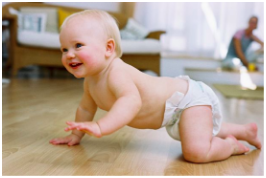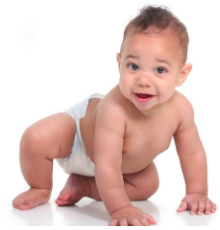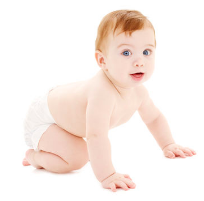The “Dos and Dont’s” of Baby Crawling
If your baby is beginning to push up onto their hands and knees, they may be getting ready to crawl! Baby Crawling, or “creeping,” is an important motor milestone that builds the foundation for higher level motor skills including walking, running, climbing, ball skills, and playground skills. Most children begin to crawl between seven and nine months of age. Typical crawling builds strength, develops visual skills, facilitates cognitive development, and coordinates both sides of the body. Because of these many benefits, it is ideal children learn to crawl on hands and knees. However, your baby may be demonstrating another form of crawling or floor mobility.
Let’s break down the many forms of crawling and their impact on development:
TYPICAL BABY CRAWLING (“Creeping”)

Characteristics of typical crawling:
- Baby is on hands and knees in an “all fours” position
- Uses both side of the body equally, advancing each limb in front of the other
- One knee advances at time, knees do not move together
- Body moves reciprocally and symmetrically; when left arm moves forward, the right leg moves forward
- Knees are lined up under hips, stance is not too wide
- Core is engaged, the back is not too arched and the tummy is not too rounded
Impact on development:
- Develops strength in the shoulder, neck, abdominals and hip muscles
- Can create visual skills, specifically using the eyes together and depth perception
- Develops symmetrical and reciprocal movement or using both sides of the body together
ASYMMETRICAL CRAWLING

Some babies learn to crawl with one knee and one foot. This is an asymmetrical pattern that we want to avoid. It may be caused by underlying asymmetry in the muscles, hips or in their body awareness. This crawling pattern encourages your baby to use one side of their body more than the other. It can affect strength, vision, and coordinating both sides of the body.
Characteristics of asymmetrical baby crawling:
- Baby uses one foot and one knee instead of two knees
- Pelvis is shifted to one side and spine is curved to one side
- He/She prefers to lift one hand more than the other when reaching for toys
Impact on development:
- Baby is not aware of their “true midline,” which will impact their ability to use both sides of their body together as well as their visual orientation to midline
- Spine is repetitively curved to one side, which may lead to scoliosis
- Due to the difference in hip positions, the hip girdle and surrounding musculature develop differently from side to side
- Future skills, such as learning to stand, may development asymmetrically by preferring to use one side of the body only to push to stand or weight shift over
“BUNNY HOP” CRAWLING

Some babies learn to crawl by using both legs at the same time, or “hopping” their knees together while moving. It can result from difficulty with coordination of both sides of the body, weakness, tightness or high muscle tone, and impaired hip mobility. This crawling pattern does not promote increased of hip mobility and leg flexibility and can in turn affect walking, running, and climbing.
Characteristics of bunny hop crawling:
- Hands and knees position, but legs do not dissociate (move opposite each other)
- Both knees “hop” forward together when crawling
- Knees tuck under chest during crawl
Impact on development:
- Baby may have difficulty transitioning from sit to all fours
- Overuse of hip flexor muscles, weakness in hip extensor (gluteal) muscles
- Poor development of reciprocal movement (flexing one leg while extended the other)
- Decreased trunk rotation and development of core musculature
“FROG LEG” CRAWLING: Crawling with wide base of support
Some babies learn to crawl with their knees very far apart. This indicates weakness in the core and hips and/or increased mobility in the hip joints. It may be difficult for your baby to crawl due to this weakness.
Characteristics of baby crawling with a wide base of support:
- Knees are far apart and not lined up under hips
- Core is not engaged, sagging belly and arched back
- Crawling is effortful and your baby may prefer not to do it
Impact on development:
- Baby may learn to w-sit
- Due to this alignment, baby cannot activate abdominal and hip musculature, making crawling on hands and knees difficult
- Weakness in hip and abdominal muscles continues
BOTTOM SCOOTING

Some babies will scoot on their bottoms in a sitting position for mobility. Although they may like this new freedom, scooting does not carry the benefits that come with crawling on hands and knees. It also limits the amount of movements and transitions that the babies do to get to their tummies and back to sitting.
Characteristics of scooting:
- Baby is in sitting instead of four point position
- He/She may move forward by pushing with hands and pulling with heels
- Baby may move forward by keeping their hands off of the ground and pulling with their heels only
- He/She may use one side of the body more than the other
Impact on development:
- Baby does not develop neck, shoulder, abdominal and hip muscle strength
- Spine is repetitively curved to one side, which may lead to scoliosis
- Due to the difference in hip positions, hip joints and hips muscle develop differently from side to side
- Future skills, such as learning to stand, may develop asymmetrically, as these children prefer to use one leg over the other
As you can see, not all baby crawling is created equal! It is important to have intervention at this stage. Children are at a fast pace of learning when they finally become mobile! Movement is exciting for all involved, but we want to make sure your child is not “practicing” poor movement patterns all day long. Remember, symmetrical crawling now means symmetrical walking later! If you see any of these atypical forms of crawling or mobility, please call the specialists at Chicago Pediatric Therapy & Wellness Center for a physical therapy assessment to help get your little one back on track! We can be reached at 773-687-9241 or info@cptwc.com. Happy crawling!


